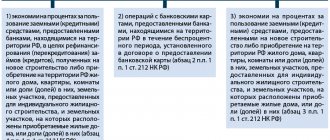In practice, an accountant often has to deal with processing transactions for issuing an interest-free or interest-bearing loan to an employee of an organization. Let's consider accounting for loans to employees and interest on them in the 1C 8.3 Accounting 3.0 program. Let's study in the form of step-by-step instructions, using the example of postings, how to reflect loans issued to employees in 1C Accounting 8.3, how to calculate interest on loans in 1C 8.3, as well as calculate the material benefits from savings for using borrowed funds and withholding personal income tax.
Interest-free loan: basic provisions
The issuance of interest-free loans to employees is regulated by the Civil Code, namely the 1st paragraph of Chapter 42. The subject of the loan can be both money and things. In this case, an agreement must be concluded in writing between the employer and the employee (Article 808 of the Civil Code of the Russian Federation). The contract must state that the loan is interest-free. Otherwise, the default interest rate will be equal to the refinancing rate (Article 809 of the Civil Code of the Russian Federation). However, there are exceptions. If the agreement of the parties does not contain a word about interest, then the loan will be considered interest-free when:
- the agreement was concluded between citizens for an amount less than or equal to 50 minimum wages, not for business purposes;
- Things are given on loan.
In addition, the contract must specify the return period. If such a date is not specified, the borrower must be prepared to repay the debt within 30 days after receiving a request to do so. Also, at his discretion, an employee can repay an interest-free loan (hereinafter referred to as the LO) ahead of schedule.
Concept of interest-free loan
An interest-free loan to an employee is represented by the issuance of a certain amount of money for various purposes without the need for the employee to pay interest for the use of borrowed funds. The features of such lending include:
- the employer can set low interest rates that do not exceed the inflation rate;
- all conditions must be agreed upon by the two participants in advance;
- Not only funds, but also property belonging to the company can be transferred for use;
- by law, the loan size cannot exceed 50 times the minimum wage;
- It is not allowed to use the received funds for commercial purposes;
- the employee can return the funds in parts or in full;
- it is allowed to repay the loan ahead of schedule;
- The recipient of the funds will have to pay taxes on the money received.
The company does not have to pay taxes on the funds returned by the employee, since the company does not have interest income.
An interest-free loan was issued: accounting
Let's consider what entries an accountant should make for an interest-free loan to an employee. For settlements of loans to employees, the chart of accounts approved by Order of the Ministry of Finance of the Russian Federation dated October 31, 200 No. 94n provides for account 73.
| Description | Dt | CT | Documentation |
| Posting for issuing an interest-free loan to an employee in cash | 73.1 | 50 (51) | Expenditure cash order (payment order, bank statement) |
| Posting for repayment of cash balance by employee | 50 (51) | 73.1 | Receipt cash order (payment order, bank statement) |
The financial investment account is not used in transactions for interest-free loans issued to employees; this is indicated in the instructions for the chart of accounts for account 58. It is also necessary to pay attention to the reflection of transactions for personal income tax, which must be paid if the employer does not charge interest on the loan. Read more about personal income tax in the following sections.
| Description | Dt | CT | Documentation |
| Personal income tax withheld from income from non-payment of interest on the loan | 70 | 68 | Tax registers |
| Personal income tax is transferred to the budget | 68 | 51 | Payment order, bank statement |
Connecting loan accounting
The use of the loan accounting mechanism in 1C ZUP 8.3 is enabled in the payroll settings through the Loans to employees (Settings - Payroll).
After checking the box, the document journal Loans to employees (Salaries - See also) with the following documents becomes available:
- Employee loan agreement;
- Issuing a loan to employees;
- Changing the terms of a loan agreement for an employee;
- Repaying a loan to an employee.
Also in the document Calculation of salaries and contributions, the Loans tab will appear .
Taxation of material benefits
The MV amount is the tax base for personal income tax (Article 210 of the Tax Code of the Russian Federation). The tax is calculated at a rate of 35% for residents and 30% for non-residents (clauses 2–3 of Article 224 of the Tax Code of the Russian Federation). Thus, from the employee’s income, which the employer pays him monthly, the corresponding percentage of personal income tax from his MV from the BZ must be withheld. The amount of deduction cannot be more than 50% of income in cash, which is paid this month (clause 4 of article 226 of the Tax Code of the Russian Federation). If the withholding amount exceeds the maximum, the balance is carried over to the next month. If it was not possible to withhold personal income tax during the tax period, the employer must inform both the tax office and the employee about this by sending them a 2-NDFL certificate. The employer pays the withheld personal income tax on the day of payment of income or the next (clause 6 of Article 226 of the Tax Code of the Russian Federation); personal income tax cannot be paid in advance (clause 9 of Article 226 of the Tax Code of the Russian Federation).
An example of calculating personal income tax from the material benefit of saving on interest with an interest-free ruble loan from ConsultantPlus On May 20, 2021, an employee was given an interest-free loan of 100,000 rubles. for one year. We calculate the payoff on the loan as of May 31, 2021 - for 11 days (from May 21 to May 31). Matvygoda... You can view the full example in K+ by getting free trial access.
Registration of loan repayment by an employee in the middle of the month
An employee can repay part of the loan by depositing the amount into the cash register or into the organization’s current account. To register this fact in ZUP 3.1, the document Repayment of a loan to an employee .
If synchronization is configured between the ZUP 3.1 program and Accounting 3.0, then information about loan repayment will be transferred to ZUP 3.1 from the documents Cash receipt and/or Receipt to current account , in which the type of operation Loan repayment by employee .
At the same time, in ZUP 3.1 documents are created and recorded (not posted) Repayment of a loan to an employee . In it, you need to select the loan agreement under which the loan is repaid and carry it out.
When this document is carried out, the principal debt is repaid, and the accumulated interest is also calculated for the period from the date of the last repayment (which could occur either in the Calculation of salaries and contributions , or in another document Repayment of a loan to an employee ) to the date of the current repayment.
In addition, the mat is calculated on the maturity date. benefit also for the period from the date of the last repayment to the date of the current repayment.
Let's look at the previously used example to see how this happens.
By the beginning of January 2022, Hakobyan’s employee still had the principal debt on the loan in the amount of:
- 100,000 (loan amount issued) - 7,096.77 (repaid in December) = RUB 92,903.23.
On January 20, 2020, the employee repays RUB 25,000. loan
Let's calculate what interest was accrued to the employee for the period from 01/01/2020 to 01/20/2020 for using the remaining debt of 92,903.23 rubles:
- 92,903.23 (loan balance on the calculation date) * 2% / 366 (calendar days in the year of calculation) * 20 (calendar days from the date of last repayment) = 101.53 rubles.
Loan Repayment document after it is completed shows this amount of interest, as well as the amount of the principal debt.
In current releases of ZUP 3.1, the total amount of debt reflected in the document Repayment of a loan to an employee is incorrect, it is different from the amounts shown here. In this case, the decryption amounts displayed are correct.
The document also calculates material benefits and registers the calculation of personal income tax on this material benefit. It can be seen in the Document Movements (command More - Document Movements in the document Repayment of a Loan to an Employee) in the Income Accounting for Personal Income Tax calculation and Taxpayer Calculations with the Personal Personal Income Tax Budget . Or in the Payslip , if you generate it before the final payment for the employee at the end of the month (before the document Calculation of salaries and contributions ).
Mat. the benefit is calculated as follows:
- 92,903.23 (loan balance on the calculation date) * (2/3 * 6.25% (refinancing rate on the last day of the month) – 2% (loan rate)) / 366 (calendar days in the year of calculation) * 20 (calendar days days from the date of last repayment) = 109.99 rubles.
Next, when calculating an employee in the document Calculation of salaries and contributions for January 2022, the planned repayment of the principal debt will occur, as well as the calculation of interest on the loan for the period from the date of the last repayment to the end of the month (in this example, from 01/21/2020 to 01/31/2020) – this is the Accrued % . And in the Repaid% the total amount of interest for the month will be shown, taking into account the percentage that was calculated in the document Repayment of a loan to an employee .
Accrued % column :
- 67,903.23 (loan balance on the calculation date) * 2% / 366 (calendar days in the year of calculation) * 11 (calendar days from the date of last repayment) = 40.82 rubles.
Column Repaid % :
- 40.82 (interest calculated in the document Calculation of salaries and contributions ) + 101.53 (interest calculated in the document Repayment of a loan to an employee ) = 142.35 rubles.
As for the material benefit, it will also be calculated for the period from the date of the last repayment (from January 20, 2020):
- 67,903.23 (loan balance on the calculation date) * (2/3 * 6.25% (refinancing rate on the last day of the month) – 2% (loan rate)) / 366 (calendar days in the year of calculation) * 11 (calendar days days from the date of last repayment) = 44.22 rubles.
Separately, it should be noted that when calculating material benefits, the refinancing rate set on the last day of the month is used. Those. even if the refinancing rate changed on December 16, 2019, and the loan is repaid on December 13, 2019, the rate that is in effect at the end of the month—12/31/19—should still be used.
However, there is a bug in the current releases of ZUP 3.1. When registering loan repayment, the refinancing rate in effect on the repayment date is used, and not on the last day of the month.
Read more about this in the material: Material benefit is incorrectly determined if the month saw a loan repayment and a change in the key rate of the Central Bank of the Russian Federation
Interest-free loan for home purchase
Taxation of personal income tax for MV has exceptions specified in subsection. 1 clause 1 art. 212 of the Tax Code of the Russian Federation. One of them is that if the purpose of the BP is defined as the construction or acquisition of housing in our country, as well as land for its construction, then the MV for such BP is not recognized as income. In this case, the employee to whom such a work permit was issued must have the right to a property deduction. This deduction must be confirmed by a special notice issued by the tax authority, the form of which was approved by order of the Federal Tax Service of the Russian Federation dated January 14, 2015 No. ММВ-7-11/ [email protected]
Thus, until the employee brings the specified notice, the accountant withholds personal income tax from him every month from the MV according to the BZ. After confirmation of the right to a property deduction, personal income tax is not accrued, however, the employer cannot return previously withheld personal income tax amounts, since they are not considered excessively withheld in accordance with clause 1 of Art. 231 Tax Code of the Russian Federation. You can return personal income tax amounts that were withheld before the notification was provided yourself at the tax office at your place of residence. Such clarifications are given in the letter of the Ministry of Finance of the Russian Federation dated March 21, 2013 No. 03-04-06/8790.
NOTE! From 2022, financial benefits arising during mortgage holidays are not subject to personal income tax.
Interest-free loan in kind: taxation
An employee’s knowledge book can be issued to the company’s goods, materials, fixed assets, etc. The things transferred must be defined by generic characteristics, that is, they cannot be unique with specific characteristics that only they have. A non-monetary loan can be repaid in money or the same things. The main qualities of the transferred items should be indicated in the contract (name, grade, quantity, size, etc.) so that the borrower returns the corresponding property.
When issuing this type of work permit, the employer must take into account some taxation nuances. As for income tax, the transfer of money or things as a loan is not considered an expense (clause 12 of Article 270 of the Tax Code of the Russian Federation), and repayment of the loan is not considered income (clause 10 of Article 251 of the Tax Code of the Russian Federation). Cash loans are not subject to VAT (subclause 15, clause 3, article 149 of the Tax Code of the Russian Federation). Under a non-monetary loan agreement, the employer's property becomes the property of the employee. In paragraph 1 of Art. 39 of the Tax Code of the Russian Federation, the sale is equated to the transfer of ownership of things, and, according to subparagraph. 1 clause 1 art. 146 of the Tax Code of the Russian Federation, the sale is called an object for VAT. Therefore, the transfer of things under the BZ agreement is subject to VAT. The price of the transferred property is determined as the current market price. When calculating such VAT, the employer has the right to deduct the corresponding input VAT that he paid when purchasing valuables transferred under the BZ.
Example 2
01/01/2021 V. A. Sokolov received ceramic tiles produced at the Voskhod LLC enterprise, where he works, as a BZ. The cost of the tiles was 135,000 rubles. without VAT. The loan term is 1 year. The employer must pay VAT to the budget in the amount of 135,000 rubles. × 20% = 27,000 rub.
Interest-free loan in kind: accounting
The accounting value of the transferred assets may or may not correspond to their assessment in the business contract. If a difference exists, it will be reflected in other income or expenses. In accounting, transactions on business history are reflected as follows:
| Description | Dt | CT | Documentation |
| The book value of the property was written off when issuing a business license | 73.1 | 41 (01, 10…) | Transfer and acceptance certificate (invoice) |
| Income is reflected if the contract value is higher than the book value | 73.1 | 91.1 | Transfer and acceptance certificate (invoice) |
| An expense is reflected if the contract price is lower than the book value | 91.2 | 73.1 | Transfer and acceptance certificate (invoice) |
| VAT is charged on the amount of the loan issued by the property | 73.1 | 68 subaccount “VAT” | Invoice |
| Repayment of debt in kind with property or money | 41 (01, 10, 50, 51…) | 73.1 | Acceptance certificate (invoice), payment order, bank statement |
Example 2 (continued)
The book value of the tiles was 105,000 rubles. Let's assume that the refinancing rate did not change throughout the year and amounted to 9% (conditionally). Then the personal income tax amount will be equal to: 35% × 2/3 × 9% × 159,300 = 3,345 rubles. The accountant recorded the following entries:
| Description | Dt | CT | Sum |
| The book value of the property was written off when issuing a business license | 73.1 | 41 | 105 000 |
| The excess of the contract value over the book value is reflected | 73.1 | 91.1 | 30 000 |
| VAT is charged on the amount of the loan issued by the property | 73.1 | 68 subaccount “VAT” | 24 300 |
| BZ extinguished | 41 | 73.1 | 159 300 |
| Personal income tax withheld from MV according to BZ | 70 | 68 subaccount “NDFL” | 3 345 |
| Personal income tax is transferred to the budget | 68 subaccount “NDFL” | 51 | 3 345 |
Rules for drawing up a contract
If the head of the company makes a positive decision on the application, then an interest-free loan agreement is drawn up for the employee. For this purpose, a form specially developed by the company can be used. A distinctive feature of this document is the absence of interest accrual.
The following information must be included in this agreement:
- the subject of the contract, represented by the transfer of funds from the employer to the employee;
- the purpose for which the loan is issued;
- duration of the agreement;
- the rights and obligations of each party involved in the transaction;
- liability of the parties;
- grounds for terminating the contract before the end of its validity period;
- rules on the basis of which disputes arising between the borrower and the employer are resolved;
- force majeure situations that may affect the cooperation of the two parties.
Information about the borrower is required, including place of work, position held, passport details, place of residence and contact details. Information about the company is also entered, so its name, legal address, as well as other important details are indicated.
If the subject of the loan is not cash, but some property of the organization, then an act of acceptance and transfer of valuables is additionally formed. Often a payment schedule is drawn up containing information on what days the borrower must repay the funds to the company.
Particular attention is paid to the fines that the borrower will have to pay if he violates important terms of the contract for various reasons. They usually depend on the size of the loan and are calculated based on the Central Bank refinancing rate. A sample interest-free loan agreement with an employee can be viewed below.
Results
Currently, organizations are finding various ways to motivate employees; one of the options may be issuing a work permit. However, we must not forget that, despite the absence of interest, the employee will still incur associated expenses in the form of personal income tax with MV. And the responsibility for calculating and paying this tax to the budget lies with the employer.
Read about the BC for organizations in our article “Is an interest-free loan subject to income tax?”
You can find more complete information on the topic in ConsultantPlus. Free trial access to the system for 2 days.






